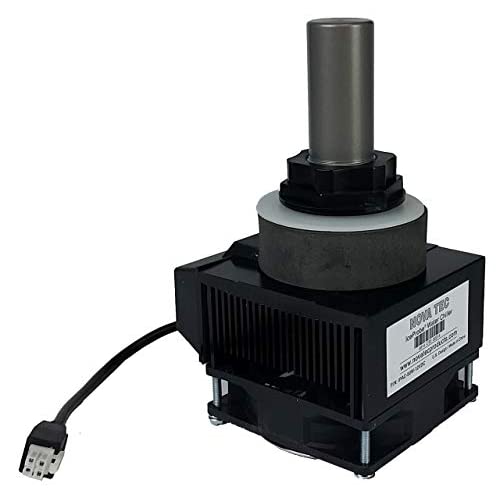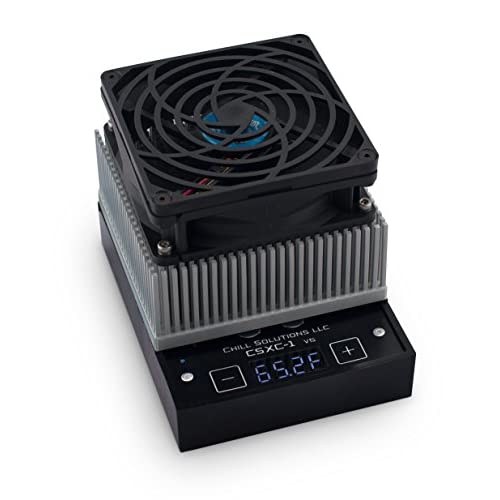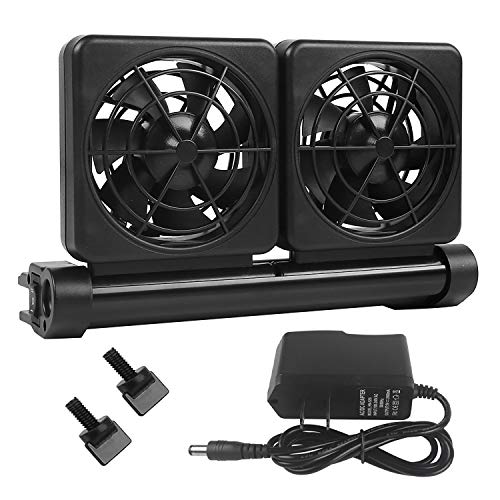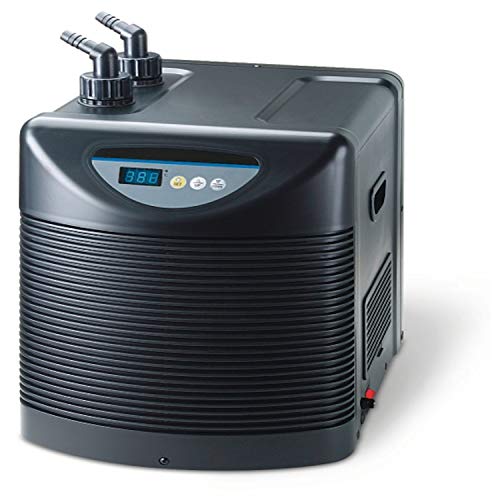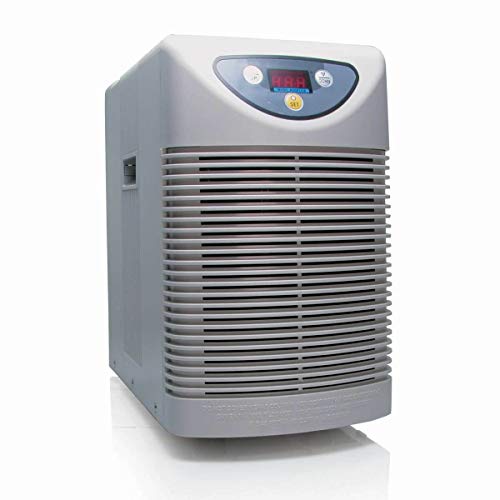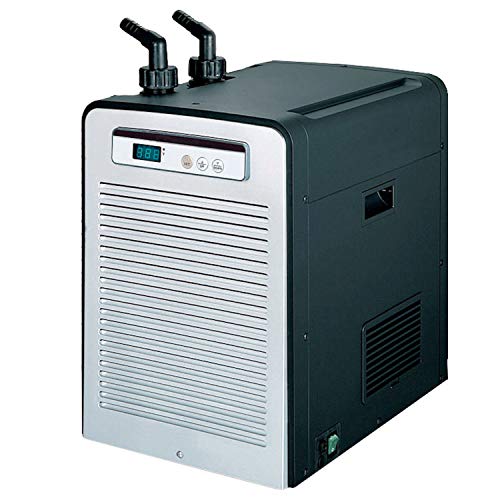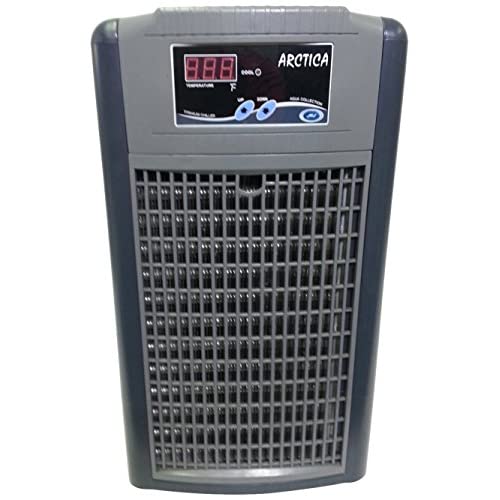The temperature of the water profoundly affects aquarium inhabitants. That’s because fish, crabs, and corals are cold-blooded. Their body temperature is determined by their environment.
Various factors might make aquarium water too warm. For example, the light, the pump, and the filter could be contributing heat. Or the tank could be affected by sunlight or warm room air.
You can try fixing the problem by increasing the water flow inside the tank or relocating the aquarium to a cooler place. But when all else fails, it’s time to invest in an aquarium chiller. Aquarists who use chillers will tell you that these devices save a lot of effort and worry.
Top aquarium chillers
#1 Nova Tec IceProbe Thermoelectric Aquarium Chiller
If you have a small aquarium up to 10 gallons in size, try the Nova Tec IceProbe. It may remind you of a heatsink on a computer processor.
The top of the chiller is a probe that you insert into the water of your aquarium. You can do this by mounting the device on top of the aquarium, or drilling a hole and inserting the 3-inch long probe into the tank, sump, or filtration system.
The chiller constantly runs unless you turn it on and off, connected to a timer, or attach it to a thermostat controller. It’s covered by a one-year warranty against defects.
Some customers report that it the IceProbe is nearly silent. Others complain that it’s noisy. The discrepancy is most likely due to the chillers’ location. Otherwise, most owners seem satisfied with its ability to drop the temperature in their aquarium by a few degrees.
#2 Chill Solutions 11415 CSXC-1 Thermoelectric Aquarium Chiller
The Chill Solutions Thermoelectric Chiller also resembles the heatsink of a computer processor. But instead of a probe, you’ll connect it to a water pump. Then the pump will circulate tank water through tubing into the chiller and back into the tank. And it can reduce the temperature in saltwater or freshwater aquariums up to 30 gallons in size.
The best feature is that there is a programmable thermostat on this chiller. You can set it between 45 to 90°F. That way you don’t need any other equipment to control the temperature.
The manufacturer states that the CSXC-1 chiller can pull down the temperature by up to 10°F for a 10-gallon tank, 5-8°F for a 20-gallon tank, and 2-4°F for a 30-gallon tank. And it performs this task without the use of any refrigerants and without making noise.
#3 Petzilla Aquarium Chiller, Fish Tank Cooling Fan System for Salt Fresh Water
What could be simpler than cooling a tank with fans? Petzilla’s solution for reducing the temperature of your tank water is evaporation. They offer setups of one to six fans that clip-on to the edge of your tank. You can adjust the angle up to 90° so that they blow right on to the water.
Petzilla explains that their inexpensive chiller lowers the temperature up to 7°F. You’ll have some control over the effectiveness of the fans by adjusting the speed and the angle at which they circulate air. If the system isn’t working well for you, they offer a 30-day money-back guarantee plus a one-year warranty and free user support.
On the upside, this aquarium chiller is very inexpensive. On the downside, the fact that it speeds up evaporation means you’ll need to stay on top of adding fresh water. And the clips themselves only fit on aquariums that are less than half an inch in thickness.
#4 Hamilton Technology Aqua Euro Max Aquarium Chiller
The Aqua Euro Max Chiller comes in a variety of sizes to suit large and small aquariums of any type. Each one operates quietly and efficiently and comes with a programmable LED display. Plus, the electronic controller will remember your settings in case the power fails.
Inside the chiller is a rust-resistant titanium evaporator that uses ozone-friendly refrigerant. As a result, it can reduce the temperature of the water down to 20°F below room temperature.
The only things you need to operate the chiller are a water pump and tubing. The tubing connects with half-inch fittings. And the water pump you use has to match the requirements of the chiller. Check the specifications before you buy.
#5 Hydrofarm Active Aqua Chiller
Hydrofarm’s Active Aqua Chiller uses refrigerants and a titanium evaporator to cool down water in saltwater and freshwater aquariums, or hydroponic systems. It attaches to either half-inch or three-quarter-inch tubing and requires a separate water pump with an appropriate flow rate.
You can program the chiller with the touchpad and LCD. Depending on the horsepower you’ve purchased, you can cool your aquarium a significant amount. For example, the 1/4HP chiller with 960 BTU drops the temperature of a 13-gallon aquarium by 30°F over the course of a day.
The manufacturer offers a one-year warranty. And the device itself is protected against electrical surges.
#6 Apex Chiller ¼ HP from Aqua Euro
Although we’re reviewing the 1/4HP Apex Chiller from Aqua Euro, you can purchase other versions with less or more power depending on your needs. It’s very quiet and vibrates little. Plus, it uses the R134a refrigerant that’s safe for the ozone layer.
Similar to other Aqua Euro chillers, this one has a titanium heat exchanger or evaporator. This material is resistant to corrosion from saltwater.
Owners recommend placing the chiller where it has good ventilation because it produces hot air. You’ll also want a water pump with the flow rate that matches the requirements of the chiller.
#7 JBJ Aquarium Arctica Titanium Chiller
The JBJ Aquarium Arctica Chiller is a refrigerator for your tank’s water. It has a built-in programmable thermostat that’s accurate within plus or minus 1°F. And the digital controller has a backlit screen that’s readable day or night.
The titanium coils stand up to freshwater and saltwater without corroding. And you can connect either half-inch or three-quarter-inch tubing. Just be sure your water pump matches the recommended flow rate of the chiller.
While the JBJ Arctica is similar to chillers from other brands, it has one important advantage. The manufacturer offers a two-year warranty where many of the other companies only offer one year. Also, if you visit their website, you can use their online calculator to choose the appropriate size chiller for your aquarium.
Selecting the best aquarium chiller
When you’re shopping for an aquarium chiller, all the specifications about BTUs, horsepower, and flow rate can be a little overwhelming. Let’s see if we can make the choice a little easier.
First, there are three main things you must know before you buy a chiller. The most important fact is the recommended temperature range for the inhabitants of your tank. The second detail is the average temperature you’re reading that’s too high. And the third thing is the size of your aquarium in gallons.
For example, if you have goldfish, they prefer temperatures between 68 and 74°F. But if their aquarium water averages 78°, you’ll need to drop the temperature at least 4°F. Let’s imagine that they live in a 20-gallon tank.
Now let’s consider your options based on the chillers in our review today. If you used the Petzilla chiller, you would want either the two or three-fan system. Although this may be the least expensive choice, it might not cool down the water by 4°F, and you’ll need to compensate for the evaporation.
A better choice would be the Chill Solutions CSXC-1. It’s rated to pull down the temperature of a 20-gallon tank by up to 8°F. Plus, it’s programmable.
You might also try one of the chillers that use refrigerant and condensers to reduce the temperature. These are generally much more expensive for a small tank.
If you want one of the titanium chillers like the JBJ or Aqua Euro, the manufacturers provide guidelines to help you make the right choice. For example, the 1/4HP models generally reduce the temperature of 100-gallon tank by up to 30°F. But as the volume of water increases, their effectiveness decreases.
Just like when you purchase any other piece of aquarium equipment like a heater or pump, buy bigger. Favor the more powerful device because you will be able to handle updates to your aquarium in the future.
Emergency chillers for when the power goes out
If the electricity goes off, you can still cool your aquarium without a chiller. It’s time to go back to basics. Grab a bottle of water conditioner and a bucket. Keep an eye on your thermometer as you add cold water to the tank. You can circulate the freshwater and aerate it at the same time by using a cup to scoop water from the tank, then pour it back inside.
Another solution that requires less effort is to float bottles of frozen water in the aquarium. You can also float thin-walled sealed containers filled with ice cubes. Since cold water sinks to the bottom of the tank, this is a surprisingly effective solution.
If you have battery-powered fans available, you can cool the water by evaporation. But no matter what method you choose, it’s essential that you keep an eye on the thermometer. And if you see the fish rising to the surface and gasping for air, take urgent action to circulate the water and cool it down.
Conclusion
Depending on how much you want to cool your tank’s water, there are three kinds of aquarium chillers you can use. Some are inexpensive and appropriate for occasional use, while others are best suited to aquariums where the temperature is a critical factor. Once you know how much cooling you need, it’s not hard to choose the best chiller.
